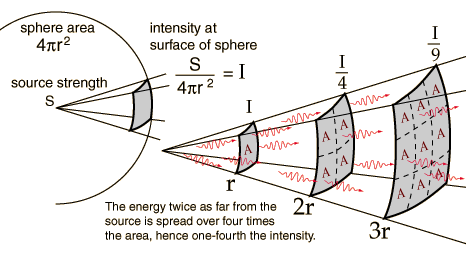This is the last week of post topics from the review for the hygiene written boards. Today is the inverse square law and how this applies to changing the PID/cone length and exposure settings for a comparable image density.
Inverse square law
The inverse square law applies to any source where the x (material, energy, etc.) being emitted goes in all directions. This applies to x rays as they are emitted in all directions when they are produced. It states that “The intensity of the influence at any given radius r is the source strength divided by the area of the sphere” (Georgia State University). See diagram below.
 What this means is that if you are at a distance (r) from the source when that distance is doubled (2r) there is 1/4 the amount of radiation at this distance. And when that distance is tripled (3r), there is 1/9 the amount of radiation at this distance.
What this means is that if you are at a distance (r) from the source when that distance is doubled (2r) there is 1/4 the amount of radiation at this distance. And when that distance is tripled (3r), there is 1/9 the amount of radiation at this distance.
Inverse square law and PID/cone length
How the inverse square law comes into play is changing the PID/cone length of an x ray unit. For example, changing the PID/cone length from 8 inches to 16 inches doubles the initial distance (2r). This means that there is 1/4 the radiation exiting from the 16 inch PID/cone versus the 8 inch PID/cone. To ensure your image density stays the same with this longer PID/cone, you would need to increase the exposure time 4 times. If the PID was increased by 3x, such as a 24 inch PID/cone (I’m not aware that these exist but for learning purposes I’m using it 😀 ) this would be 1/9 the amount of radiation exiting the 24 inch PID/cone. For comparable image density the time would need to be increased 9 times.
Take home points
Double (2r) PID/cone length = Increase exposure time 4 times
Triple (3r) PID/cone length = Increase exposure time 9 times
Should you have any questions or thoughts on this topic (I realize its a little more complex than some of the last few), please let me know.
Thanks and enjoy!

